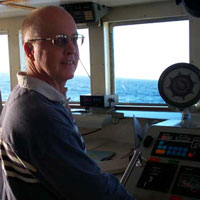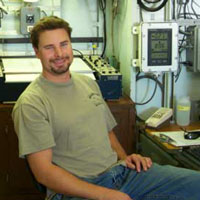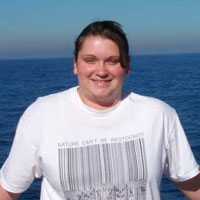


The Project
|
Daily JournalDecember 10, 2004: People Who Work and Study at Sea
Captain John Manion
|
Brent Riemer |
Brent Riemer
Resident Marine Technician
Brent grew up in the southern California area and has spent most of his life around the ocean. He left California to attend Colorado State University where he earned a BS in biology with a minor in Chemistry. When he returned to California, he worked for two years as a biologist for a company that was installing fiber optic cable from San Luis Obispo to Oxnard, California.
Question 5: How far is it from San Luis Obispo to Oxnard?
Brent returned to school for a year, earning a Marine Technology degree, commercial diving license, EMT and other related certifications at Santa Barbara City College. He has worked as a commercial diver and for the EPA. When Scripps Institute of Oceanography called to interview him for a position as Resident Marine Technician, Brent jumped at the opportunity to learn more by working with various scientists on different data gathering expeditions. A resident marine technician is the liaison between the scientists and the ship's crew. He has been at Scripps for two years and is looking forward to more adventures when he moves on to a larger vessel early next year. The larger vessel will sail to New Zealand and then onto Japan.
Question 6: In what hemisphere is New Zealand? Japan?
What Brent likes most about his job is the opportunity to constantly learn new things. He is responsible for making sure the scientists have all the things they need to conduct their data gathering . Brent also enjoys the critical thinking and problem solving aspects of his job. The only drawback he sees in his position is being away from home for up to 6 months out of a year..
The qualifications Brent thinks is most important for his position are a BS in one of the sciences and athletic ability, but not necessarily strength. It is also important not to have a fear of heights and not to get seasick.
Question 7: Choose a job you are interested in and list the qualifications necessary to be good at that job.
Daniela Zima |
Daniela Zima
graduate student
Daniela is working on an MS degree in Chemical Oceanography. She grew up in New Jersey where she spent a lot of time at the seashore. She was able to pursue her interest in oceans by attending a marine science high school. As a freshman in high school, she began doing studies on the growth rate and patterns of clams. These studies became part of her senior thesis. Also during high school she was selected to be part of a PBS program that presented ocean science to children. After graduation, she was a part of the group that did flatfish research on the Hudson River.
Question 8: Using a map, find where the Hudson River originates and where the mouth of the river is.
As an undergraduate, Daniela attended Stockton College in New Jersey. She majored in marine biology with a minor in chemistry. In her junior year, she worked for the Environmental Protection Agency (EPA) monitoring shellfish. Her group collected and weighed clams in order to monitor the population level. If the number of clams was dropping, they needed to figure out the cause. Some possible causes might be over fishing or pollution. A decrease in the population would result in putting the clams off limits to both commercial and recreational fishers.
Question 9: What are 3 kinds of shellfish?
Daniela now attends the College of Oceanic and Atmospheric Sciences at Oregon State University in Corvallis, Oregon. Her current research looks at water circulation in the Arctic region. She is looking at how global warming affects ocean flow patterns. If there is increased warming of the planet, there will be more fresh water that goes into the ocean. With global warming, more heavy metals will end up in the oceans. Daniela looks at the cadmium and barium levels in clam shells to monitor levels of pollution. Cadmium is found in most plastics, batteries, and most industrial waste. Barium can be found in plastics and ceramics.
Question 10: What is a heavy metal? (This is not a music question).
Daniela helps with all the scientific work on the current New Horizon cruise. Her tasks range from sampling sediment cores to running the A-frame (a crane). When Daniela graduates, she would like to work for the EPA
Bonus Question of the Day (submitted by Chris Moser): The title of a book by Jules Verne is "Twenty Thousand Leagues Under the Sea." How far is a league and what is the origin of this word? What distance does "twenty thousand leagues under the sea" refer to?
![]()



